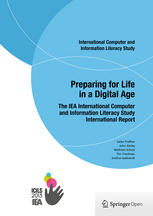

Most ebook files are in PDF format, so you can easily read them using various software such as Foxit Reader or directly on the Google Chrome browser.
Some ebook files are released by publishers in other formats such as .awz, .mobi, .epub, .fb2, etc. You may need to install specific software to read these formats on mobile/PC, such as Calibre.
Please read the tutorial at this link: https://ebookbell.com/faq
We offer FREE conversion to the popular formats you request; however, this may take some time. Therefore, right after payment, please email us, and we will try to provide the service as quickly as possible.
For some exceptional file formats or broken links (if any), please refrain from opening any disputes. Instead, email us first, and we will try to assist within a maximum of 6 hours.
EbookBell Team

4.1
50 reviewsAbility to use information and communication technologies (ICT) is an imperative for effective participation in today’s digital age. Schools worldwide are responding to the need to provide young people with that ability. But how effective are they in this regard? The IEA International Computer and Information Literacy Study (ICILS) responded to this question by studying the extent to which young people have developed computer and information literacy (CIL), which is defined as the ability to use computers to investigate, create and communicate with others at home, school, the workplace and in society.
The study was conducted under the auspices of the International Association for the Evaluation of Educational Achievement (IEA) and builds on a series of earlier IEA studies focusing on ICT in education.
Data were gathered from almost 60,000 Grade 8 students in more than 3,300 schools from 21 education systems. This information was augmented by data from almost 35,000 teachers in those schools and by contextual data collected from school ICT-coordinators, school principals and the ICILS national research centers.
The IEA ICILS team systematically investigated differences among the participating countries in students’ CIL outcomes, how participating countries were providing CIL-related education and how confident teachers were in using ICT in their pedagogical practice. The team also explored differences within and across countries with respect to relationships between CIL education outcomes and student characteristics and school contexts.
In general, the study findings presented in this international report challenge the notion of young people as “digital natives” with a self-developed capacity to use digital technology. The large variations in CIL proficiency within and across the ICILS countries suggest it is naive to expect young people to develop CIL in the absence of coherent learning programs. Findings also indicate that system- and school-level planning needs to focus on increasing teacher expertise in using ICT for pedagogical purposes if such programs are to have the desired effect.
The report furthermore presents an empirically derived scale and description of CIL learning that educational stakeholders can reference when deliberating about CIL education and use to monitor change in CIL over time.